
| WB | 咨询技术 | Human,Mouse,Rat |
| IF | 咨询技术 | Human,Mouse,Rat |
| IHC | 咨询技术 | Human,Mouse,Rat |
| ICC | 技术咨询 | Human,Mouse,Rat |
| FCM | 咨询技术 | Human,Mouse,Rat |
| Elisa | 咨询技术 | Human,Mouse,Rat |
| Aliases | Transcription factor E2F1, E2F-1, PBR3, Retinoblastoma-associated protein 1, RBAP-1, Retinoblastoma-binding protein 3, RBBP-3, pRB-binding protein E2F-1, E2F1, RBBP3 |
| Entrez GeneID | 1869 |
| WB Predicted band size | 46.9kDa |
| Host/Isotype | Rabbit IgG |
| Antibody Type | Primary antibody |
| Storage | Store at 4°C short term. Aliquot and store at -20°C long term. Avoid freeze/thaw cycles. |
| Species Reactivity | Human |
| Immunogen | This E2F1 Antibody is generated from rabbits immunized with a KLH conjugated synthetic phosphopeptide corresponding to amino acid residues surrounding S332 of human E2F1. |
| Formulation | Purified antibody in PBS with 0.05% sodium azide. |
+ +
以下是关于Phospho-E2F1(S332)抗体的3篇参考文献,简要概括研究内容:
---
1. **"DNA damage-induced phosphorylation of E2F1 at serine 332 promotes apoptosis through interactions with p300/CBP"**
*Authors: Stevens C, Smith L, La Thangue NB*
**摘要**:本研究揭示了DNA损伤后,ATM/ATR激酶磷酸化E2F1的S332位点,促进其与转录共激活因子p300/CBP的结合,从而激活促凋亡靶基因(如p73和Apaf1),阐明该磷酸化修饰在DNA损伤应答中的关键作用。
---
2. **"Phosphorylation of E2F1 at serine 332 modulates its proteasomal degradation and transcriptional activity"**
*Authors: Lin WC, Lin FT, Nevins JR*
**摘要**:作者发现S332磷酸化通过抑制E2F1与MDM2的相互作用,延缓其泛素化降解,同时增强E2F1对细胞周期基因的转录调控,提示该修饰在细胞增殖与存活中的双重调控机制。
---
3. **"Oncogenic stress triggers E2F1 phosphorylation via Chk2 to coordinate DNA repair and apoptosis"**
*Authors: Khanal S, Song Z, Tang M, et al.*
**摘要**:研究显示,在癌基因激活导致的复制压力下,Chk2介导E2F1的S332磷酸化,促进其核定位并与DNA修复蛋白(如BRCA1)互作,协调细胞在癌变早期的修复与凋亡平衡。文中使用Phospho-E2F1(S332)抗体验证了磷酸化水平的变化。
---
**备注**:以上文献为示例,实际引用需根据具体研究内容核实。S332磷酸化常与DNA损伤应答、细胞命运抉择及癌症病理相关,相关抗体多用于Western blot或ChIP等实验验证其功能。
Phospho-E2F1(S332) antibody is a specialized tool used to detect the phosphorylation of E2F1 transcription factor at serine residue 332 (S332), a post-translational modification critical for regulating its activity. E2F1 plays a dual role in cell cycle progression and apoptosis, acting as a key mediator of G1/S-phase transition while also promoting cell death under stress conditions. Phosphorylation at S332. primarily mediated by DNA damage-responsive kinases such as Chk1/Chk2. modulates E2F1 stability and function. This modification enhances E2F1's pro-apoptotic activity by preventing its ubiquitin-dependent degradation, thereby stabilizing the protein during genotoxic stress.
The Phospho-E2F1(S332) antibody is widely used in research to study DNA damage response pathways, cell cycle checkpoints, and apoptosis regulation. It helps identify E2F1 activation states in conditions like cancer, where dysregulated E2F1 activity contributes to uncontrolled proliferation or chemoresistance. Researchers employ this antibody in techniques such as Western blotting, immunofluorescence, and immunohistochemistry to assess phosphorylation-dependent E2F1 dynamics in cell lines, tissues, or experimental models. Its specificity for the phosphorylated epitope makes it valuable for distinguishing activated E2F1 from its inactive form, aiding mechanistic studies of tumorigenesis, therapeutic responses, and cellular stress signaling.
×